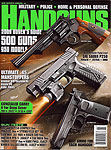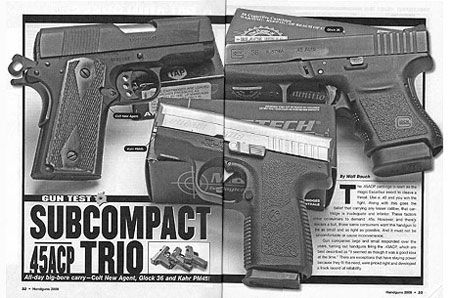
SUBCOMPACT .45ACP TRIO
All-day big-bore carry – Colt New Agent, Glock 36 and Kahr PM45!
GUN TEST | Handguns 2009 Buyer's Guide, p. 32-37 By Walt Rauch

The .45ACP cartridge is seen as the magic Excalibur sword to cleave a threat. Use a .45 and you win the fight. Along with this goes the belief that carrying any lesser caliber that cartridge is inadequate and inferior. These factors drive consumers to demand .45s. However, and there's always a but, those same consumers want the handgun to be as small and as light as possible. And it must not be uncomfortable or cause inconvenience.
Gun companies large and small responded over the years, turning out handguns firing the .45ACP which are best described as “it seemed as though it was a good idea at the time.” There are exceptions that have staying power because they fit the need, were priced right and developed a track record of reliability.
The 1911 was the first to undergo a shortening and lightening in the post-World War II Colt Lightweight Commander, with its 4.25-inch top end and aluminum frame for a weight of 26 ounces, 13 ounces less than the original 1911. When I asked years ago why Colt didnít make a subcompact 1911, a senior Colt executive told me the Colt engineers were adamant in their claim that the 1911 platform was unreliable with a barrel/slide combination of less than 4.25 inches. They were correct for what they had to work with then, the original 1911 parts. They saw a limit to how much these could be reduced without affecting reliability.
Colt New Agent
Obviously, Colt eventually did and does make a subcompact 1911, the New Agent Model, which is a revision of the Colt Defender.
The New Agent only differs from the Defender slightly. The normal fixed sights are gone, replaced with a longitudinal groove on the top of the slide. Slimmer, checkered wood grips are also standard, which makes the package even more concealable. The other benefit of these narrower grips, a smaller hand can get a good hold on the gun. The front strap also has vertical gold cup-style serrations.
This new “sight” more correctly reflects the gunís intended use, up close and fast. My best efforts with this sighting setup start to fall apart after 15 yards. With deliberate shooting, I can keep five rounds in a very nice, small group. Past this, though, my results are “iffy.” The flatter checkered grips are still adequate and, the mainspring housing is grooved beneath a reduced size grip safety. The manual safety used here is the GI style with a short, protruding, flat-checkered stud to operate it.
What was needed was the dual recoil spring system invented and patented by Leander Seecamp of pocket pistol fame. With this, the short slide was able to move with sufficient force for a subcompact 1911 to operate properly, albeit within limitations. This spring system needs much more frequent replacement compared to the full-size 1911.
Semi-automatic pistols depend on “timing” to run reliably. The slide must run fully to the rear to pick up a round from the magazine at a very precise instant with no room for error on either side of this action. This critical juncture of working parts is much less precise in the full-sized version. As such, the subcompact 1911 must have its recoil spring system and the magazine spring always delivering a particular amount of spring tension and doing so with springs that will not provide this exact tension after a relatively few rounds have been fired. One friend of mine who is quite knowledgeable of these things flatly asserts any subcompact 1911 must have its dual recoil spring changes every 300 rounds and this is when firing standard-velocity ammo, not +P.
When we get to the shortened 6-round magazine, here, too, spring tension is critical and this is exacerbated when the gun maker, attempting to satisfy customer demand and gain a competitive edge, uses a McCormick split follower as Colt now does. This is only made worse when coupled with an even shorter magazine spring to allow the loading of a seventh round. My suggestion (and my practice) is to not use this extra round feature and load only six rounds. And don't cut corners by loading seven and chambering one round because itís quicker. Simply loading and unloading one round will “work” the spring, causing it to weaken.
The subcompact 1911, though, is not Everyoneís choice, since more than a few folks are uncomfortable carrying a cocked and locked pistol. The alternatives are carrying the gun with its hammer down over a live round or with an empty chamber, as they see getting the gun up and running to take too much time. This problem can be solved, as illustrated by the two other subcompacts, the Glock 36 and Kahr Arms PM45.
The discussion of springs also applies to these models, since the same requirements are present. Their timing is more critical as all their parts are reduced in size, but are also expected to perform to the same level as their larger kin. It is interesting to see how Glock and Kahr Arms addressed these conditions.
Glock 36
The Glock pistol is about as simple and user-friendly as a semi-auto can be. It is also extremely reliable and its durability second to none. The Glock uses a Tenifer finish on its primary metal parts and its frame is made from a variation of a polymer (Dupont 66) which is equally as durable, if not more so, than metal. The Glock is a 20th century version of the revolver. Load it, pull the trigger to fire and otherwise keep your finger off its Safe Action Trigger The trigger is more double-action than single-action, but doesnít fit either technical definition. What it does provide, though, is a relatively heavy, 6 to 9 pound but short trigger pull. It moves further to fire than the single-action but less than the double-action trigger. In effect, you get the best of both (trigger) worlds in a carry pistol.
The Glock 36 uses a dual recoil spring, but the Glock system is longer (with matching slide configuration) than those used in the Colt and Kahr pistols. It, too, should be changed frequently.
An examination of the G36 magazine shows that much thought has gone into developing it. Technically, it is a staggered rather than a single-column magazine. While wider and longer than the Colt and Kahr magazines, It is set up to hold only six rounds. Its base pad encircles the magazine body, allowing a stronger and longer spring. It is apparent to me that Mr. Glock made a deliberate effort to ensure reliability over super compactness.
Iíve tested one and found that it runs with all standard-velocity and the few +P loads I fired. Range accuracy is all that one could ask for. When I do my part and donít jerk the trigger, I get 2-inch five-shot groups at 20 yards from a seated and arm-rested position. This sample happens to have the original white dot front and white outline square notch rear sight changed to Heinie Straight Eight night sights by its owner. Which are the better? My wife swears by Glock factory sights, as do many others. I like them and the Heinie sights too. Fortunately, the Glock sights are dovetailed into the slide and are easily removed or adjusted for windage. The frame is stippled on its sides with raised cross-hatching on front and backstrap and, like all Glocks, gives the shooter a good gripping surface.
Kahr PM45
 Kahr PM45 with two groups of five rounds each, 2.5" and 2", at 20 yards.
Kahr PM45 with two groups of five rounds each, 2.5" and 2", at 20 yards.The Kahr PM45 has evolves from the full-sized version. Justin Moon is the inventor and designer of the Kahr Arms pistol. He took features from the Glock design and added his own. He has freely acknowledged his admiration for the Glock design.
The Kahr Arms pistol uses a trigger mechanism similar to the Glock, but Moon figured out a way to give much more of a double-action trigger pull feel to it. The Kahr pistols are quite slim and made from either all stainless steel or stainless steel slides on a polymer frame. Beginning with a compact pistol, Moon both downsized and up-sized his design. Here, he did his work in further reducing the size of his P45 pistol into the PM45.
The Kahr guns use the same dual recoil spring system as the Glock and the Colt New Agent. I queried a Kahr Arms representative concerning the PM45ís spring life and was told replacing it every 1000 rounds is advised, assuming standard-velocity loads. Moon's answer to proper timing was very much correct by limiting magazine capacity to five rounds in a magazine body, which could well hold six, particularly if a hollow base pad were to be used.
Range work with the PM 45 was the same as líve experienced with all the Kahr pistols in other calibers Iíve tested, reliable, accurate, easy to use. And, they have no external manual safeties. Trigger pull weight runs in the 6 pound range and to use and it works like a double-action revolver.
Five rounds fired supported from a table rest will do 2-inch groups from 15 yards without much effort. The sights are three white dots or three tritium inserts surrounded by white in the ramp front and square notch rear and dovetailed into the slide. The frame is “checkered” and pebbled for gripping.
Final Notes
Comparing these three subcompacts, the Kahr PM45 is the thinnest and smallest, with the Colt New Agent holding the middle ground. The Glock 36 is the largest.
As far as how to choose among them, I suggest the choice be made on a matter of how one feels in your hand, with this criteria tempered by ease of operation. The nice part about making such a choice is there are three good ones here from which to choose.
<< Go back to Previous Page